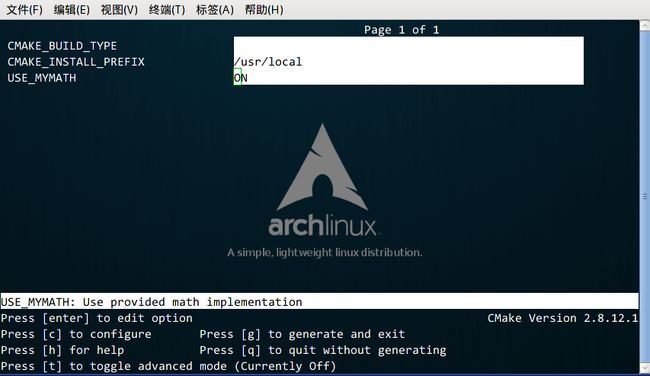Cmake入门
什么是 CMake
All problems in computer science can be solved by another level of indirection.
David Wheeler
你或许听过好几种 Make 工具,例如 GNU Make ,QT 的 qmake ,微软的MS nmake,BSD Make(pmake),Makepp,等等。这些 Make 工具遵循着不同的规范和标准,所执行的 Makefile 格式也千差万别。这样就带来了一个严峻的问题:如果软件想跨平台,必须要保证能够在不同平台编译。而如果使用上面的 Make 工具,就得为每一种标准写一次 Makefile ,这将是一件让人抓狂的工作。
CMake图 1 CMake就是针对上面问题所设计的工具:它首先允许开发者编写一种平台无关的 CMakeList.txt 文件来定制整个编译流程,然后再根据目标用户的平台进一步生成所需的本地化 Makefile 和工程文件,如 Unix 的 Makefile 或 Windows 的 Visual Studio 工程。从而做到“Write once, run everywhere”。显然,CMake 是一个比上述几种 make 更高级的编译配置工具。一些使用 CMake 作为项目架构系统的知名开源项目有VTK、ITK、KDE、OpenCV、OSG 等 1。
在 linux 平台下使用 CMake 生成 Makefile 并编译的流程如下:
- 编写 CMake 配置文件 CMakeLists.txt 。
- 执行命令
cmake PATH或者ccmake PATH生成 Makefile 1 1ccmake和cmake的区别在于前者提供了一个交互式的界面。。其中,PATH是 CMakeLists.txt 所在的目录。 - 使用
make命令进行编译。
本文将从实例入手,一步步讲解 CMake 的常见用法,文中所有的实例代码可以在这里找到。如果你读完仍觉得意犹未尽,可以继续学习我在文章末尾提供的其他资源。
入门案例:单个源文件
本节对应的源代码所在目录:Demo1。
对于简单的项目,只需要写几行代码就可以了。例如,假设现在我们的项目中只有一个源文件 main.cc ,该程序的用途是计算一个数的指数幂。
|
|
编写 CMakeLists.txt
首先编写 CMakeLists.txt 文件,并保存在与 main.cc 源文件同个目录下:
|
|
CMakeLists.txt 的语法比较简单,由命令、注释和空格组成,其中命令是不区分大小写的。符号 # 后面的内容被认为是注释。命令由命令名称、小括号和参数组成,参数之间使用空格进行间隔。
对于上面的 CMakeLists.txt 文件,依次出现了几个命令:
cmake_minimum_required:指定运行此配置文件所需的 CMake 的最低版本;project:参数是main,该命令表示项目的名称是 main 。add_executable: 将名为 main.cc 的源文件编译成一个名称为 Demo 的可执行文件。
编译项目
之后,在当前目录执行 cmake . ,得到 Makefile 后再使用 make 命令编译得到 Demo1 可执行文件。
|
|
多个源文件
同一目录,多个源文件
本小节对应的源代码所在目录:Demo2。
上面的例子只有单个源文件。现在假如把 power 函数单独写进一个名为 MathFunctions.c 的源文件里,使得这个工程变成如下的形式:
|
|
这个时候,CMakeLists.txt 可以改成如下的形式:
|
|
唯一的改动只是在 add_executable 命令中增加了一个 MathFunctions.cc 源文件。这样写当然没什么问题,但是如果源文件很多,把所有源文件的名字都加进去将是一件烦人的工作。更省事的方法是使用 aux_source_directory 命令,该命令会查找指定目录下的所有源文件,然后将结果存进指定变量名。其语法如下:
|
|
因此,可以修改 CMakeLists.txt 如下:
|
|
这样,CMake 会将当前目录所有源文件的文件名赋值给变量 DIR_SRCS ,再指示变量 DIR_SRCS 中的源文件需要编译成一个名称为 Demo 的可执行文件。
多个目录,多个源文件
本小节对应的源代码所在目录:Demo3。
现在进一步将 MathFunctions.h 和 MathFunctions.cc 文件移动到 math 目录下。
|
|
对于这种情况,需要分别在项目根目录 Demo3 和 math 目录里各编写一个 CMakeLists.txt 文件。为了方便,我们可以先将 math 目录里的文件编译成静态库再由 main 函数调用。
根目录中的 CMakeLists.txt :
|
|
该文件添加了下面的内容: 第3行,使用命令 add_subdirectory 指明本项目包含一个子目录 math,这样 math 目录下的 CMakeLists.txt 文件和源代码也会被处理 。第6行,使用命令 target_link_libraries 指明可执行文件 main 需要连接一个名为 MathFunctions 的链接库 。
子目录中的 CMakeLists.txt:
|
|
在该文件中使用命令 add_library 将 src 目录中的源文件编译为静态链接库。
自定义编译选项
本节对应的源代码所在目录:Demo4。
CMake 允许为项目增加编译选项,从而可以根据用户的环境和需求选择最合适的编译方案。
例如,可以将 MathFunctions 库设为一个可选的库,如果该选项为 ON ,就使用该库定义的数学函数来进行运算。否则就调用标准库中的数学函数库。
修改 CMakeLists 文件
我们要做的第一步是在顶层的 CMakeLists.txt 文件中添加该选项:
|
|
其中:
- 第7行的
configure_file命令用于加入一个配置头文件 config.h ,这个文件由 CMake 从 config.h.in 生成,通过这样的机制,将可以通过预定义一些参数和变量来控制代码的生成。 - 第13行的
option命令添加了一个USE_MYMATH选项,并且默认值为ON。 - 第17行根据
USE_MYMATH变量的值来决定是否使用我们自己编写的 MathFunctions 库。
修改 main.cc 文件
之后修改 main.cc 文件,让其根据 USE_MYMATH 的预定义值来决定是否调用标准库还是 MathFunctions 库:
|
|
编写 config.h.in 文件
上面的程序值得注意的是第2行,这里引用了一个 config.h 文件,这个文件预定义了 USE_MYMATH 的值。但我们并不直接编写这个文件,为了方便从 CMakeLists.txt 中导入配置,我们编写一个 config.h.in 文件,内容如下:
|
|
这样 CMake 会自动根据 CMakeLists 配置文件中的设置自动生成 config.h 文件。
编译项目
现在编译一下这个项目,为了便于交互式的选择该变量的值,可以使用 ccmake 命令 2 2也可以使用 cmake -i 命令,该命令会提供一个会话式的交互式配置界面。:
从中可以找到刚刚定义的 USE_MYMATH 选项,按键盘的方向键可以在不同的选项窗口间跳转,按下 enter 键可以修改该选项。修改完成后可以按下 c 选项完成配置,之后再按 g 键确认生成 Makefile 。ccmake 的其他操作可以参考窗口下方给出的指令提示。
我们可以试试分别将 USE_MYMATH 设为 ON 和 OFF 得到的结果:
USE_MYMATH 为 ON
运行结果:
|
|
此时 config.h 的内容为:
|
|
USE_MYMATH 为 OFF
运行结果:
|
|
此时 config.h 的内容为:
|
|
安装和测试
本节对应的源代码所在目录:Demo5。
CMake 也可以指定安装规则,以及添加测试。这两个功能分别可以通过在产生 Makefile 后使用 make install 和make test 来执行。在以前的 GNU Makefile 里,你可能需要为此编写 install 和 test 两个伪目标和相应的规则,但在 CMake 里,这样的工作同样只需要简单的调用几条命令。
定制安装规则
首先先在 math/CMakeLists.txt 文件里添加下面两行:
|
|
指明 MathFunctions 库的安装路径。之后同样修改根目录的 CMakeLists 文件,在末尾添加下面几行:
|
|
通过上面的定制,生成的 Demo 文件和 MathFunctions 函数库 libMathFunctions.o 文件将会被复制到 /usr/local/bin 中,而 MathFunctions.h 和生成的 config.h 文件则会被复制到 /usr/local/include 中。我们可以验证一下3 3顺带一提的是,这里的 /usr/local/ 是默认安装到的根目录,可以通过修改 CMAKE_INSTALL_PREFIX 变量的值来指定这些文件应该拷贝到哪个根目录。:
|
|
为工程添加测试
添加测试同样很简单。CMake 提供了一个称为 CTest 的测试工具。我们要做的只是在项目根目录的 CMakeLists 文件中调用一系列的 add_test 命令。
|
|
上面的代码包含了四个测试。第一个测试 test_run 用来测试程序是否成功运行并返回 0 值。剩下的三个测试分别用来测试 5 的 平方、10 的 5 次方、2 的 10 次方是否都能得到正确的结果。其中 PASS_REGULAR_EXPRESSION 用来测试输出是否包含后面跟着的字符串。
让我们看看测试的结果:
|
|
如果要测试更多的输入数据,像上面那样一个个写测试用例未免太繁琐。这时可以通过编写宏来实现:
|
|
关于 CTest 的更详细的用法可以通过 man 1 ctest 参考 CTest 的文档。
支持 gdb
让 CMake 支持 gdb 的设置也很容易,只需要指定 Debug 模式下开启 -g 选项:
|
|
之后可以直接对生成的程序使用 gdb 来调试。
添加环境检查
本节对应的源代码所在目录:Demo6。
有时候可能要对系统环境做点检查,例如要使用一个平台相关的特性的时候。在这个例子中,我们检查系统是否自带 pow 函数。如果带有 pow 函数,就使用它;否则使用我们定义的 power 函数。
添加 CheckFunctionExists 宏
首先在顶层 CMakeLists 文件中添加 CheckFunctionExists.cmake 宏,并调用 check_function_exists 命令测试链接器是否能够在链接阶段找到 pow 函数。
|
|
将上面这段代码放在 configure_file 命令前。
预定义相关宏变量
接下来修改 config.h.in 文件,预定义相关的宏变量。
|
|
在代码中使用宏和函数
最后一步是修改 main.cc ,在代码中使用宏和函数:
|
|
添加版本号
本节对应的源代码所在目录:Demo7。
给项目添加和维护版本号是一个好习惯,这样有利于用户了解每个版本的维护情况,并及时了解当前所用的版本是否过时,或是否可能出现不兼容的情况。
首先修改顶层 CMakeLists 文件,在 project 命令之后加入如下两行:
|
|
分别指定当前的项目的主版本号和副版本号。
之后,为了在代码中获取版本信息,我们可以修改 config.h.in 文件,添加两个预定义变量:
|
|
这样就可以直接在代码中打印版本信息了:
|
|
生成安装包
本节对应的源代码所在目录:Demo8。
本节将学习如何配置生成各种平台上的安装包,包括二进制安装包和源码安装包。为了完成这个任务,我们需要用到 CPack ,它同样也是由 CMake 提供的一个工具,专门用于打包。
首先在顶层的 CMakeLists.txt 文件尾部添加下面几行:
|
|
上面的代码做了以下几个工作:
- 导入 InstallRequiredSystemLibraries 模块,以便之后导入 CPack 模块;
- 设置一些 CPack 相关变量,包括版权信息和版本信息,其中版本信息用了上一节定义的版本号;
- 导入 CPack 模块。
接下来的工作是像往常一样构建工程,并执行 cpack 命令。
- 生成二进制安装包:
|
|
- 生成源码安装包
|
|
我们可以试一下。在生成项目后,执行 cpack -C CPackConfig.cmake 命令:
|
|
此时会在该目录下创建 3 个不同格式的二进制包文件:
|
|
这 3 个二进制包文件所包含的内容是完全相同的。我们可以执行其中一个。此时会出现一个由 CPack 自动生成的交互式安装界面:
|
|
完成后提示安装到了 Demo8-1.0.1-Linux 子目录中,我们可以进去执行该程序:
|
|
关于 CPack 的更详细的用法可以通过 man 1 cpack 参考 CPack 的文档。
将其他平台的项目迁移到 CMake
CMake 可以很轻松地构建出在适合各个平台执行的工程环境。而如果当前的工程环境不是 CMake ,而是基于某个特定的平台,是否可以迁移到 CMake 呢?答案是可能的。下面针对几个常用的平台,列出了它们对应的迁移方案。
autotools
- am2cmake 可以将 autotools 系的项目转换到 CMake,这个工具的一个成功案例是 KDE 。
- Alternative Automake2CMake 可以转换使用 automake 的 KDevelop 工程项目。
- Converting autoconf tests
qmake
- qmake converter 可以转换使用 QT 的 qmake 的工程。
Visual Studio
- vcproj2cmake.rb 可以根据 Visual Studio 的工程文件(后缀名是
.vcproj或.vcxproj)生成 CMakeLists.txt 文件。 - vcproj2cmake.ps1 vcproj2cmake 的 PowerShell 版本。
- folders4cmake 根据 Visual Studio 项目文件生成相应的 “source_group” 信息,这些信息可以很方便的在 CMake 脚本中使用。支持 Visual Studio 9/10 工程文件。
CMakeLists.txt 自动推导
- gencmake 根据现有文件推导 CMakeLists.txt 文件。
- CMakeListGenerator 应用一套文件和目录分析创建出完整的 CMakeLists.txt 文件。仅支持 Win32 平台。
相关链接
- 官方主页
- 官方文档
- 官方教程
- Wiki
- FAQ
- bug tracker
- 邮件列表:
- cmake on Gmane
- http://www.mail-archive.com/[email protected]/
- http://marc.info/?l=cmake
- 其他推荐文章
- 在 linux 下使用 CMake 构建应用程序
- cmake的一些小经验
- Packaging Software with CPack
- 视频教程: 《Getting Started with CMake》
类似工具
- SCons:Eric S. Raymond、Timothee Besset、Zed A. Shaw 等大神力荐的项目架构工具。和 CMake 的最大区别是使用 Python 作为执行脚本。
